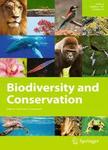版权所有:内蒙古大学图书馆 技术提供:维普资讯• 智图
内蒙古自治区呼和浩特市赛罕区大学西街235号 邮编: 010021

作者机构:Univ Ottawa Dept Biol Ottawa ON K1N 9B4 Canada Univ Lethbridge Dept Biol Sci Lethbridge AB T1K 6T5 Canada
出 版 物:《BIODIVERSITY AND CONSERVATION》 (Biodiversity Conserv.)
年 卷 期:2024年第33卷第14期
页 面:4295-4318页
核心收录:
学科分类:0710[理学-生物学] 0830[工学-环境科学与工程(可授工学、理学、农学学位)] 07[理学] 09[农学] 0713[理学-生态学]
基 金:NSERC Undergraduate student research award NSERC Canada Graduate Scholarship NSERC Discovery Grant
主 题:Calibration area Geographic extent Background Ecological niche model Independent-AUC Stacked species distribution model Peripheral populations Maxent
摘 要:Species distribution models (SDMs) are often generated to inform conservation plans. When developed for use in spatially-restricted areas, such as protected areas, investigators often make arbitrary decisions as to the geographic extent from which locality data to inform the model are drawn (i.e. the study extent of the model). However, there has been little attention to the impacts of this decision on model predictions. Here we explore the impacts of study extent on SDM predictions of (i) suitable habitat for or (ii) the actual occurrence of individual species, as well as on (iii) the identification of sites that could support multiple species (i.e. from stacked-SDMs). Focusing on six amphibian species of conservation concern at the edge of their range in western Canada, we generated SDMs using range-wide, ecoregion, and political study extents and compared the alternative predictions for each species in one of two national parks of interest. Differences in model predictions were substantial, with precent agreement among models developed with different extents as low as 10% for one of the species. Study extent also influenced the ability of models to predict independent occurrence at the edge of the range, although most models performed poorly in this regard (AUC 0.7). Finally, study extent influenced stacked predictions, suggesting that uncertainty in individual species predictions muddies interpretation of SDMs at the community-level. Importantly, results varied across species and region, precluding simple recommendations for choosing a study extent;Instead, uncertainty arising from this decision should be quantified before using SDMs in conservation planning.